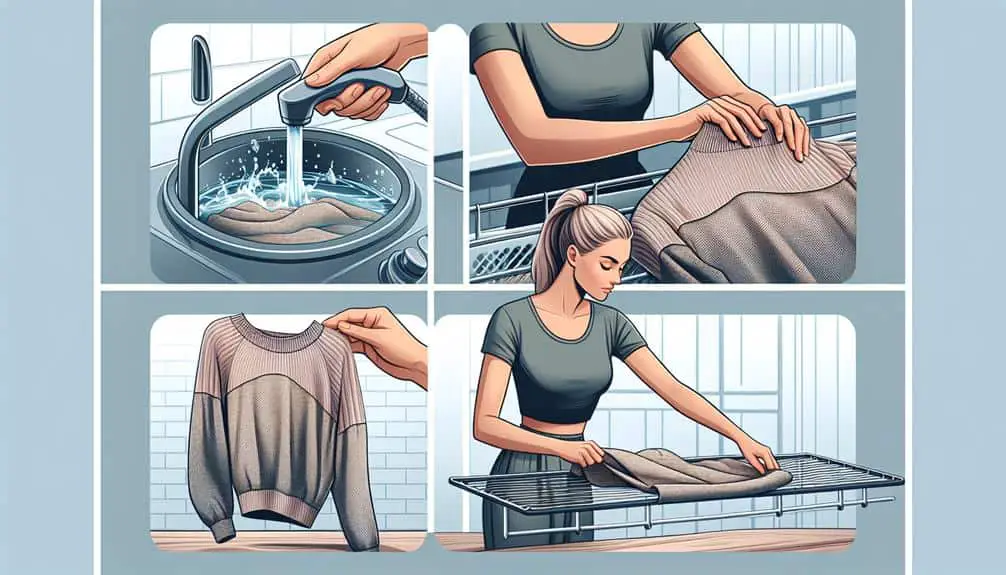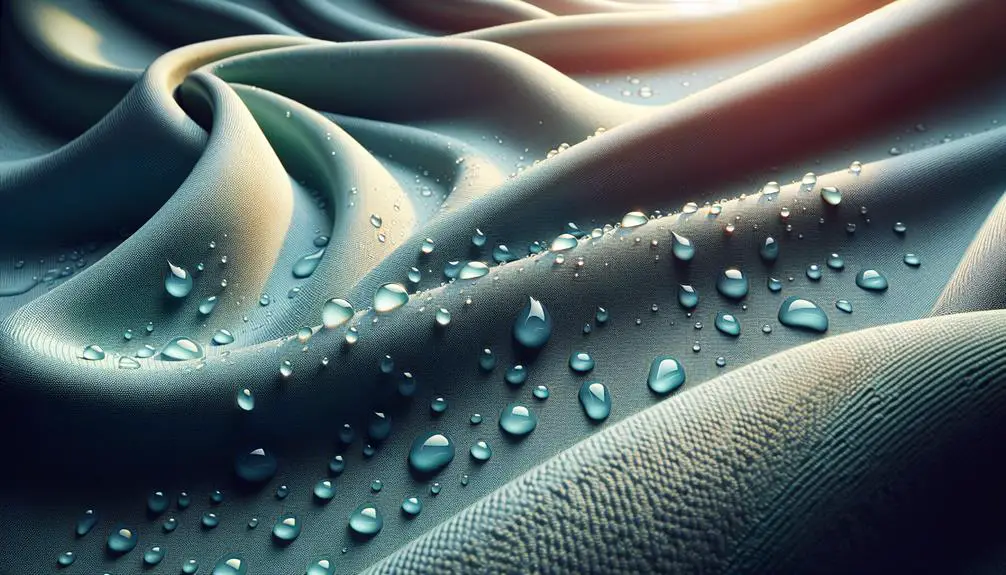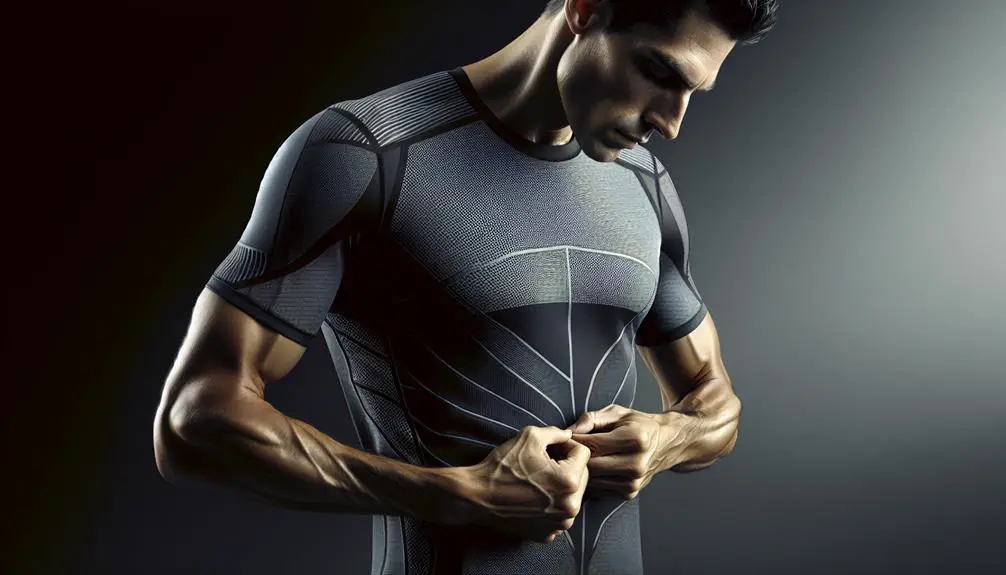To care for your moisture-wicking garments properly, follow these essential tips: Wash on a gentle cycle with cold water, no bleach, and mild detergent. Air dry away from direct sunlight or use low heat if tumble drying. Store neatly in a cool, dry place. Avoid fabric softeners to maintain wicking properties. Pre-treat stains and use appropriate detergents. Check ironing instructions, use low-medium heat, making sure garments are clean and dry. Wash after each use with gentle detergent, turn inside out, and skip fabric softeners. Mastering these steps guarantees your activewear stays fresh and functional.
Key Points
- Wash after each use to prevent bacteria buildup.
- Use mild detergent and cold water for washing.
- Air dry away from direct sunlight to maintain properties.
- Avoid fabric softeners to preserve wicking abilities.
- Store folded in a cool, dry place for longevity.
Washing Instructions
How do you properly wash moisture-wicking garments to maintain their effectiveness and longevity?
To guarantee your moisture-wicking apparel stays in top condition, always opt for the gentle cycle and cold water settings when washing. The gentle cycle helps protect the fabric's integrity, reducing wear and tear, while cold water prevents shrinkage and color fading.
Before washing, turn your moisture-wicking garments inside out to safeguard the outer surface. Avoid using fabric softeners or bleach as they can clog the moisture-wicking properties of the material. Instead, use a mild detergent that's free of these additives.
Once the washing cycle is complete, resist the urge to toss your garments into the dryer. Air drying is the best method for preserving the fabric's moisture-wicking abilities and overall quality. Hang them in a well-ventilated area away from direct sunlight, and remember to avoid using any heat sources during the drying process.
Drying Techniques
For ideal care of your moisture-wicking garments, follow specific drying techniques to maintain their performance and longevity. When it comes to drying your moisture-wicking clothes, air drying is highly beneficial. Simply lay your garments flat on a drying rack or hang them up to air dry. The natural airflow helps preserve the fabric's moisture-wicking properties and prevents any potential damage that may occur in a dryer.
However, if you prefer tumble drying, there are precautions to bear in mind. Use a low heat setting to prevent excessive heat exposure that can deteriorate the fabric's technical capabilities. It's also advisable to turn your garments inside out before placing them in the dryer to protect the outer surface and any printed designs. Additionally, avoid using dryer sheets or fabric softeners as they can leave a residue that hinders the fabric's moisture-wicking abilities.
Storing Guidelines
When storing moisture-wicking garments, make sure to use proper folding techniques to prevent creases and maintain the fabric's integrity.
Guarantee you store these garments in ideal conditions, away from direct sunlight and moisture to preserve their moisture-wicking properties.
Following these guidelines will help extend the lifespan of your moisture-wicking apparel and keep them performing at their best.
Proper Folding Techniques
To properly store your moisture-wicking garments, make sure that you fold them neatly following specific guidelines to maintain their performance and longevity. When folding, guarantee that the garments are clean and completely dry to prevent any odors or mildew.
Start by laying the garment flat on a clean surface, smoothing out any wrinkles. Fold sleeves and pant legs inwards to the center, creating a long rectangle. Then, fold the garment in thirds or quarters, depending on its size, to optimize space saving.
For travel tips and efficient packing, consider rolling your moisture-wicking garments instead of folding them to minimize creases and save space in your luggage. These folding techniques will help keep your garments in top condition for longer periods.
Ideal Storage Conditions
To maintain the peak performance and longevity of your moisture-wicking garments, it's essential to store them in ideal conditions following specific storing guidelines. Temperature control plays a vital role in preserving the quality of these garments. Aim to store them in a cool, dry place away from direct sunlight and heat sources. High temperatures can damage the fabric and affect its moisture-wicking properties.
Additionally, controlling humidity levels is important. Excess moisture in the storage area can lead to mold, mildew, and unpleasant odors in your garments. Consider using moisture-absorbing products or silica gel packs to keep humidity levels in check.
Avoiding Fabric Softeners
When caring for moisture-wicking garments, it's important to avoid fabric softeners as they can damage the garment's wicking properties.
Fabric softeners leave a residue that affects the fabric's ability to wick away moisture effectively. Instead, opt for alternative care methods like using vinegar or specialized sportswear detergents to maintain the garment's performance.
Fabric Softener Damage
Avoid using fabric softeners on moisture-wicking garments as they can diminish the fabric's moisture-wicking properties over time. Fabric softeners contain chemicals that can leave residue on the fabric, clogging the tiny spaces that help moisture move away from your skin. This residue reduces the garment's ability to wick away sweat effectively, leading to decreased breathability and moisture control.
To prevent damage and preserve the quality of your moisture-wicking garments, opt for detergent specifically designed for technical fabrics. These detergents are formulated to clean without leaving behind any residue that could interfere with the fabric's moisture-wicking capabilities. By avoiding fabric softeners and choosing the right detergent, you can prolong the effectiveness and lifespan of your moisture-wicking clothing.
Impact on Wicking
Using fabric softeners on moisture-wicking garments can compromise their ability to effectively wick away moisture over time. Fabric softeners leave a residue on the fabric, which hinders the wicking performance of the garment by clogging the fibers that are responsible for pulling moisture away from your skin.
This residue reduces the garment's drying efficiency, making it less effective at keeping you dry during physical activities. To maintain critical wicking performance and drying efficiency, it's essential to avoid using fabric softeners when caring for your moisture-wicking clothing.
Instead, opt for gentle detergents specifically designed for technical fabrics to ensure that your garments continue to perform at their best and keep you comfortable during your workouts.
Alternative Care Methods
To maintain the peak performance of your moisture-wicking garments, it's advisable to guarantee avoiding fabric softeners in your laundry routine. Fabric softeners can leave a residue on the fabric, clogging the moisture-wicking properties and reducing their effectiveness over time.
Instead of using commercial fabric softeners, opt for natural solutions or DIY alternatives to keep your moisture-wicking garments in top condition. Vinegar is a great natural alternative that helps soften clothes without leaving behind any residue. Baking soda is another DIY solution that can effectively soften and freshen your garments.
Handling Stains Properly
When dealing with stains on moisture-wicking garments, promptly address them using important cleaning methods to maintain the fabric's performance and appearance.
To start, pre-treating stains is essential for effective removal. For oily stains like sunscreen or sweat, sprinkle baking soda or cornstarch on the affected area before washing. Gently rub the powder into the stain, allowing it to absorb the oils. For protein-based stains like blood or sweat, soak the garment in cold water with enzyme detergent before washing.
When it comes to stain removal techniques, avoid using hot water as it can set the stain. Instead, opt for cold water to rinse out the stain before washing. Always check the garment's care label for specific instructions on stain removal. For stubborn stains, consider using a stain remover spray or gel. Apply the product directly to the stain, gently rub it in, and let it sit for a few minutes before washing as usual.
Ironing Recommendations
When ironing moisture-wicking garments, make sure to follow specific recommendations to preserve the fabric's integrity and performance. To guarantee the longevity of your moisture-wicking clothing, it's important to take ironing precautions that prioritize fabric protection. Begin by checking the garment's care label for any specific ironing instructions. Always use a low to medium heat setting on your iron to prevent damage to the fabric. High heat can compromise the moisture-wicking properties of the material and cause it to lose its effectiveness.
Before ironing, make sure the garment is clean and dry. If the fabric is still damp, avoid ironing it as this can lead to stretching or distortion. Additionally, consider ironing the garment inside out to protect any printed or delicate areas. When ironing, move the iron smoothly and avoid leaving it in one place for too long to prevent overheating and potential damage.
Frequency of Washing
Regularly washing your moisture-wicking garments is crucial to maintain their performance and longevity. When it comes to washing frequency, how often you clean these specialized garments depends on how frequently you wear them and the intensity of your activities. As a general guideline, it's advisable to wash moisture-wicking clothes after each use, especially if you sweat heavily or notice any lingering odors.
Extended wear without washing can lead to bacteria buildup, which not only affects the garment's odor control properties but also its overall effectiveness in wicking moisture away from your body.
To guarantee your moisture-wicking garments remain fresh and functional, consider investing in a gentle detergent specifically formulated for activewear. When laundering, turn the garments inside out, opt for a cold water wash, and avoid using fabric softeners that can hinder the fabric's moisture-wicking capabilities.
Frequently Asked Questions
Can I Use Bleach on My Moisture-Wicking Garments?
You should avoid using bleach on your moisture-wicking garments as it can damage the fabric. Instead, opt for bleach alternatives specially designed for stain removal on technical fabrics. These alternatives are gentle yet effective at maintaining the quality of your garments.
Are There Any Special Considerations for Washing My Moisture-Wicking Garments With Other Types of Clothing?
When washing your moisture-wicking garments with other clothes, be cautious. Varying washing temperatures can affect fabrics differently. Avoid fabric softeners as they can hinder the wicking properties. Consider separate drying methods to prevent damage and address stains promptly.
How Do I Know When It's Time to Replace My Moisture-Wicking Garments?
You'll notice it's time to replace your moisture-wicking garments when the fabric starts feeling less effective in managing sweat, showing signs of material degradation like pilling or thinning. Fabric lifespan varies depending on wear and care.
Can I Use a Fabric Freshener Spray on My Moisture-Wicking Garments?
Sure, fabric freshener sprays may seem like a quick fix for odor control, but they can actually decrease the longevity and performance of your moisture-wicking garments. Stick to proper fabric care methods for best results.
Are There Any Specific Detergents or Laundry Additives That Are Best for Maintaining the Moisture-Wicking Properties of These Garments?
To maintain the moisture-wicking properties of your garments, use detergents specifically designed for activewear. Regular detergents can leave residue that hinders performance. Avoid fabric softeners as they can coat the fabric and reduce moisture-wicking effectiveness.



